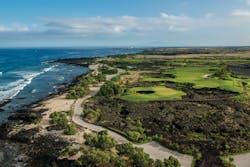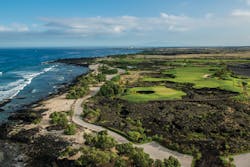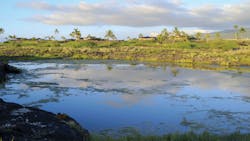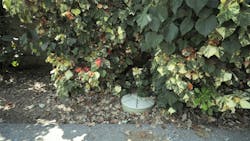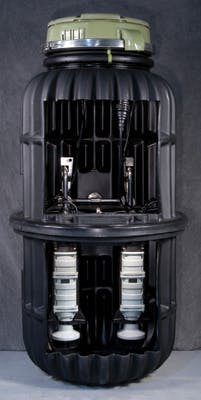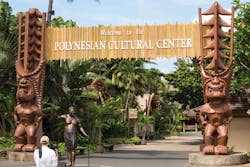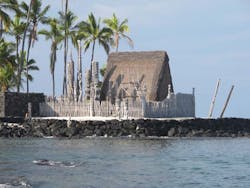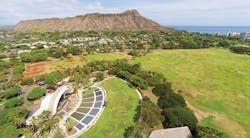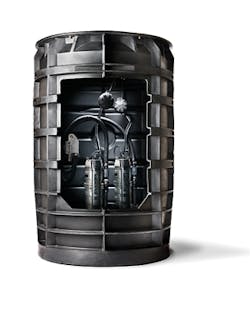Hawaii’s in Lava with Pressure Sewers
Preserving the spectacular Kona Coast and Land of Kings with an All-Terrain Sewer
By Joseph Harmes
Ever since Polynesian voyagers arrived 1,500 years ago on the Kona Coast of the island of Hawaii, the leeward district’s history of ancient traditions and mythological personages remain the state’s cultural touchstone. Basking in a warm, dry climate, this barren landscape of lava flows interspersed with fertile patches of land thrived as the residence and playground of ancient chiefs and kings such as Kamehameha I, who united the islands to become the first ruler of the Kingdom of Hawai’i. And so it remains today with new resorts and private gated communities flush with a contemporary royalty of multimillionaire and billionaire athletes, celebrities, tech entrepreneurs and financial titans.
Building in the Kona District, however, isn’t easy. The challenges begin on the upper reaches of the area, historically dedicated to agriculture, which slope to a barren middle zone of volcanic materials before arriving at the narrow, arid coastal strip. Where it’s not flat, it’s undulating. Where it’s not rocky, it’s sandy or wet. And it’s all environmentally sensitive.
The private, gated, luxury community of Kohana’iki features a Rees-Jones-designed golf course. Photo courtesy Kohana’iki.
Behind the Post Card
Reality lurks behind every dream of a tranquil, romantic life set on a tropical island paradise. Almost without exception these remote building sites lack a practical method to transport and treat wastewater.
For hundreds of years, many Hawaiians from the countryside to the suburbs have depended on “88,000 cesspools that put 53 million gallons of raw sewage into the state’s groundwater and surface waters every day,” noted a 2016 report by the Hawaii State Department of Health. It further noted that this antiquated technology (basically, a hole for untreated human waste) has the potential to pollute groundwater, a resource that over 90 percent of the state depends on for drinking water. Effluent discharges from the cesspools — loaded with pathogens, bacteria and viruses — threaten coastal resources, including coral reefs, with nitrogen and phosphorus. Surfers and snorkelers have fallen victim to skin infections.
The state has responded by requiring all cesspools be upgraded by 2050 and offering $10,000 in tax credits to elevate them to more effective wastewater treatment systems. One option is septic, also problematic given the high water tables, lava or other solid rock that can make drain fields prone to failure. The cost of a new septic system varies but generally begins around $10,000 and might double or triple depending on location, existing plumbing and available space.
Budgeting for a new septic system and leach field also encompasses disruptive excavation, possible removal and replacement of poor soil, proximity to shorelines and surface water, subsurface testing and potentially engineering services. On the windward (eastern) sides of the islands, which attract the majority of rainfall, septic drain fields often are overloaded with too much water. Pooling on the surface might also occur if water consumption in a household has increased — perhaps by the addition of an extra bathroom.
Anchialine ponds are home to unique and rare ecosystems, supporting a variety of flora and fauna endemic to Hawaii. Photo courtesy Robert Bengraff.
Digging Deep
Most of Hawaii’s urban areas depend on gravity sewer systems, whose mains can range in size from six inches to 10 feet in diameter. Some gravity sewers still incorporate terra-cotta lines from the last century or might be built with HDPE or reinforced concrete. Some older lines contain asbestos pipe.
In Hawaii, gravity sewers are especially expensive — and problematic. In Honolulu, contractors took 13 months to bore three miles of new wastewater tunnel to connect a pretreatment facility with a wastewater treatment plant serving the city and county. For a gravity system to work here, sometimes a 10-foot-diameter tunnel might have to be dug to a depth of 82 feet at the other end, noted one Honolulu environmental officer.
Inflow and infiltration is another challenge facing Honolulu authorities. Sewer overflows following intense rain storms have forced closures of some of the area’s most-visited beaches.
The Kohana’iki Experience
The private, gated, luxury community of Kohana’iki is a 450-acre “neighborhood” that includes the requisite lavish amenities: a 1-1/2 mile stretch of stunning Kona coastline, almost 400 lots for homes with seven- and eight-digit price tags, Hawaii’s only Rees Jones-designed golf course, a 120-seat chop house and sushi bar, and the Kohana’iki Clubhouse and Spa — one of the world’s largest ever built at a private club — encompassing 6.6 acres with a 67,000-square-foot, two-story main building characterized by a contemporary interpretation of traditional Hawaiian motifs.
But, perhaps the real magnetism of Kohana’iki is embodied in the exceptional respect and preservation of archaeological landmarks, petroglyphs and more than 200 sacred anchialine ponds, unique and rare ecosystems that are home to a variety of flora and fauna endemic to Hawaii. All seamlessly blend in rustic harmony with 21st century construction implementing eco-sensitive and sustainable building practices to diminish the environmental impact of the property’s transformation.
“The original descendant families were integrated into the project and they guided us towards the ethic of minimal disturbance,” said Scott Bedingfield, vice president of development and construction at Kohana’iki, a project of Beverly Hills-based real estate investment company Kennedy Wilson. It was also important that the infrastructure be concealed.
A Wastewater Technology for Hawaii’s Challenges
Mindful of the local challenges associated with septic systems and gravity sewers, the designers and engineers at Kohana’iki analyzed another option: the All-Terrain Sewer® (ATS).
Pioneered in 1969 by Environment One Corporation (E/One, Niskayuna, N.Y.), ATS pressure sewers are found today in 42 countries and U.S. territories, and on almost every continent. Tasked to operate in any climatic extreme and geography, this go-to wastewater infrastructure has cleaned up and protected islands including Martha’s Vineyard, the Florida Keys and, notably, Alcatraz. In recent years a septic-to-ATS conversion restored water quality at the legendary surfing mecca of Rincon Point Beach, California.
E/One’s ATS begins with a grinder pump station, which has a tank about the size of a dishwasher that is buried in the ground, its lid easily camouflaged with minor landscaping. Inside, the primary component is a 1-hp, semi-positive displacement pump.
The pump’s robust torque can propel wastewater through small-diameter, inflow-and-infiltration-free pressurized pipe buried just below the frost line for a distance of more than two miles — or even straight up 186 feet — to a force main or treatment plant. The total dynamic head provides a nearly identical flow rate regardless of the network’s contours and fluctuating elevations, making the ATS the appropriate technology for Hawaii’s challenging physical characteristics.
The Hard Facts
“We chose the E/One system for Kohana’iki because of the terrain,” said Robert J. McBride, project manager for the clubhouse and spa. “This is all solid rock on this island, there’s very little top soil.”
A conventional sewer system would require gravity all the way to the plant. “In the case of Kohana’iki, there would be no way to physically do that,” McBride said. “Trenches for a gravity sewer would be too deep.” With the ATS, he said, “it doesn’t make any difference if it has to go up and down on the way to the sewer treatment plant.”
“We’ve got rock and topography, our two disadvantages,” noted Robert E. Cowell, president of West Hawaii Excavating Inc. The pervasive rocky conditions mean very little depth of diggable material. “You might get a foot or two at the most,” he said. “And our terrain is not flat; we’re on the side of a mountain and so we have a lot of elevation challenges.”
Although horizontal drilling is common in many E/One installations to install pipe under roads or even rivers, it’s not a good option in lava beds. “Horizontal drilling is hard here because our rock (mostly lava) is in layers and it breaks inconsistently,” Cowell explained. “Even with impact breakers, hoe rams that we use, it still makes you work hard. It’s time and money.”
The grinder pump station is buried and its lid easily camouflaged with landscaping. Photo courtesy Robert Bengraff.
A Low-Impact, Invisible Infrastructure
From the beginning, preliminary designs indicated that a gravity sewer system wasn’t going to be feasible. “The depth of a [gravity] sewer system was greater than 20-feet in many locations,” said Nancy Burns, principal of Nancy E. Burns PE, LLC, and a consultant at Kohana’iki.
It would also have been intrusive. “The design required sewer easements through lots with sewer manholes and access requirements that were not desirable for this oceanside high-end golf community,” she added. “The E/One system was designed so that the sewer mains are entirely within the roadways. No easements across lots were required.”
“By going with pressure force main, we maintain coverage everywhere instead of ending up with gravity lines that are eight, 10, 12 feet deep with large pumping stations, all of which require a tremendous amount of hard rock excavation,” said Bedingfield. “With E/One we’re minimally intrusive enough and [the stations] are easily camouflaged with the landscape.”
According to Burns, high groundwater in other parts of the island means infiltration into the gravity sewer lines can cause excessive flow to the wastewater treatment plants, increasing the cost of wastewater treatment. “For these and other reasons it is much more cost-effective to use an E/One system, which allows for shallow pipes, eliminates the need for manholes (which contribute to infiltration of stormwater), and allows for easier connection to the sewer main due to the shallow depth of the force mains.”
Price was also a factor. “The bid amount for the E/One infrastructure was $1,458,600 in 2007,” said Burns, who is located in Kailua Kona. It included 19,351 linear feet of force main and appurtenances. By contrast, the preliminary design of the gravity system was close to $4 million.
The terrain of Kohana’iki is characterized by solid rock with very little top soil. Photo courtesy Kohana’iki.
Quiet Confidence
Operations and maintenance at Kohana’iki are handled by a nearby distributor for resident-owned units and by the in-house engineering department for properties held by Kohana’iki, which include 17 residences, the Clubhouse, beach restaurants and other facilities. Each grinder pump is monitored by an E/One Sentry Advisor™. Rather than bother a homeowner or guest with an audible alert, a modem inside the panel enclosure communicates alarms, run time, pump on, pump off and other data to the service entity.
“It’s a pretty cleverly designed system,” said McBride. “I can get two guys from the shop and have them change a pump in one hour — from the time we get a call, troubleshoot the pump, and replace it.”
A History of Hawaiian Successes
E/One’s first Hawaiian installation in the late 1990s was a more modest effort, a septic-to-sewer conversion with 200 E/One grinder pump stations in Ma¯punapuna, a private application in an older industrial area near Honolulu International Airport.
“Basically, you stick a shovel in the ground over there and the ocean comes back up out of the hole,” said Paul Scott of Engineered Systems in Kailua, E/One’s distributor. “In order to gravity sewer that flat area, because it was so low-lying, they were going to have to go down probably about 50 to 60 feet.” Because it required dewatering, the cost of gravity was estimated between $50 and $100 million, Scott said.
In late 2002 La¯‘ie, on the north shore of Oahu, launched a plan to rid itself of aged cesspools. With 750 E/One grinder pump stations, it is the largest ATS system in the state. The project was undertaken by Hawaii Reserves Inc., the subsidiary of Deseret Management Corporation that oversees the property for the Church of Jesus Christ of Latter-day Saints. Included was a $20 million wastewater collection and treatment service where wastewater is treated at a tertiary level — higher than most facilities in the state — producing reusable effluent.
Besides homes and businesses in this middle-class suburb, E/One grinder pumps service the 42-acre Polynesian Cultural Center where the history and traditions of the island nations that first settled Hawaii are incorporated into a living museum owned by Brigham Young University-Hawaii. Its six simulated tropical villages, famed luaus, performers, and arts and crafts compose one of the state’s most visited and popular tourist attractions.
Hokuli’a is a 1,260-acre high-end golf resort and 500-home residential community under development on a Kona Coast hillside with commanding views of sunsets and its pristine three-mile beach. Preserving the historical heritage of Hokuli’a is a major consideration. Hawaiian ali‘i (royalty) established their first ceremonial centers here and among the number of culturally significant sites are the remains of Hokukano Village, an ancient community; Pu’u Ohau, a sacred location of burial sites; and Nawawa Bay, a water access point where the first Hawaiians launched and landed canoes. Like Kohana’iki, it is installing All-Terrain Sewer exclusively given its similar geological and archaeological challenges.
E/One grinder pumps service the 42-acre Polynesian Cultural Center, a living museum celebrating the history and traditions of the island nations that first settled Hawaii.
Protecting the Coral Reefs
Another waterfront community — and location of one of the state’s largest collections of petroglyphs — is Puako¯, north of Kona Village. Its 800 middle-class residents are working to finance 70 E/One grinder pumps as a cost-efficient solution to replace cesspools and septic systems threatening its coral, according to a feasibility study by Clean Water for Reefs Puako¯, a community-driven project.
“Local impacts such as leaky cesspools and septic tanks release raw sewage along the Puako¯ shoreline,” the group noted. “This effluent contains nutrients and pathogens which can cause human health issues and negatively impact the Puako¯ Reef.”
Among the benefits of an ATS conversion, the group said it would “prevent an estimated 19 million gallons of Puako¯ and Waialea Bay wastewater from entering the shoreline each year.” Financially, the ATS would be the “least costly solution over a 40-year life cycle compared with other options.” WW
About the Author: Joseph Harmes is a freelance writer who has documented the evolution and acceptance curve of low-pressure sewer systems for two decades. He can be reached at [email protected].
Resurrecting a Fabled Resort
Earlier this year, Bedingfield and McBride moved to another Kennedy Wilson project, the iconic Kona Village just north of Kohana’iki, which instantly became the premier retreat for the rich and famous when it opened in 1965 (and later a hideaway for Steve Jobs). It was closed, however, after a tsunami spawned by the 2011 Japan earthquake devastated most of the rustic, low-fi, Bali Ha’i-style resort and its infrastructure.
Kona Village is a total rebuild whose mission is to recreate the same feel as the original, focused around 150 traditional hales (Hawaiian bungalows) spread over 62 acres. According to Bedingfield, Kona Village project director for Kennedy Wilson, the plans will again incorporate E/One’s ATS given its success at Kohana’iki.
The ATS was chosen for a lot of the same reasons as Kohana’iki, but “some of those reasons are more impactful, or more critical, here at Kona Village,” Bedingfield noted.
Whereas Kohana’iki had few high water tables, they are more prevalent at Kona Village. “Some of this ground is going to be wet,” said McBride, who arrived at the project in March in the role of consultant to Kennedy Wilson. “We’re going to have to dewater about a third of 22,000 feet of trench here,” he said. “There will be some E/One (grinder pump stations) whose bottoms will be in water tables but there are some construction techniques that you can use to ensure that all works okay, even though it’s in questionable ground.”
And, like Kohana’iki, Kona Village will incorporate an E/One Sentry Advisor to monitor each grinder pump.
Putting the ‘Grind’ in Grinder Pump
One of the most Instagram-worthy locations for any grinder pump in the world would certainly be the Waiki¯ki¯ Shell, a unique venue for outdoor concerts with the world-famous Diamond Head as a backdrop and Waiki¯ki¯ Beach across the street. Built in 1956, it can seat 2,000 with lawn seating for an additional 6,000 people.
“We had had wonderful success at different locations with E/Ones and in 2012 they needed to do something about the Waiki¯ki¯ Shell bathrooms,” said E/One distributor Paul Scott. “They were having problems with people putting stuff in the toilets and plugging up the lines one way or another so the grinders offered them a way of macerating this stuff that people would put down the toilets. It eliminated all of those solids problems.”
Scott recalled some initial concern about potential flow limitations with the E/One system. While most of E/One’s grinder pump stations are designed for single-family homes, larger stations with two, three, or four pumps are available. The quad system used at Waiki¯ki¯ Shell — four grinder pumps in a polyethylene station with a flat lid — collects wastewater (and some debris) and grinds it into a fine slurry.
“The quad has been in now for a number of years and we’ve never had any trouble with it,” said Scott. “It can easily keep up with the flow from the restrooms and the flow for the venue.”
